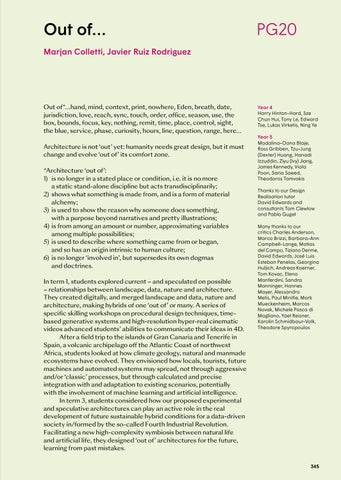Out of…
PG20
Marjan Colletti, Javier Ruiz Rodriguez
Out of*…hand, mind, context, print, nowhere, Eden, breath, date, jurisdiction, love, reach, sync, touch, order, office, season, use, the box, bounds, focus, key, nothing, remit, time, place, control, sight, the blue, service, phase, curiosity, hours, line, question, range, here… Architecture is not ‘out’ yet: humanity needs great design, but it must change and evolve ‘out of’ its comfort zone. *Architecture ‘out of’: 1) is no longer in a stated place or condition, i.e. it is no more a static stand-alone discipline but acts transdisciplinarily; 2) shows what something is made from, and is a form of material alchemy; 3) is used to show the reason why someone does something, with a purpose beyond narratives and pretty illustrations; 4) is from among an amount or number, approximating variables among multiple possibilities; 5) is used to describe where something came from or began, and so has an origin intrinsic to human culture; 6) is no longer ‘involved in’, but supersedes its own dogmas and doctrines. In term 1, students explored current – and speculated on possible – relationships between landscape, data, nature and architecture. They created digitally, and merged landscape and data, nature and architecture, making hybrids of one ‘out of’ or many. A series of specific skilling workshops on procedural design techniques, timebased generative systems and high-resolution hyper-real cinematic videos advanced students’ abilities to communicate their ideas in 4D. After a field trip to the islands of Gran Canaria and Tenerife in Spain, a volcanic archipelago off the Atlantic Coast of northwest Africa, students looked at how climate geology, natural and manmade ecosystems have evolved. They envisioned how locals, tourists, future machines and automated systems may spread, not through aggressive and/or ‘classic’ processes, but through calculated and precise integration with and adaptation to existing scenarios, potentially with the involvement of machine learning and artificial intelligence. In term 3, students considered how our proposed experimental and speculative architectures can play an active role in the real development of future sustainable hybrid conditions for a data-driven society in/formed by the so-called Fourth Industrial Revolution. Facilitating a new high-complexity symbiosis between natural life and artificial life, they designed ‘out of’ architectures for the future, learning from past mistakes.
Year 4 Harry Hinton-Hard, Sze Chun Hui, Tony Le, Edward Tse, Lukas Virketis, Ning Ye Year 5 Madalina-Oana Blaje, Ross Gribben, Tzu-Jung (Dexter) Huang, Hanadi Izzuddin, Ziyu (Ivy) Jiang, James Kennedy, Viola Poon, Saria Saeed, Theodoros Tamvakis Thanks to our Design Realisation tutor David Edwards and consultants Tom Clewlow and Pablo Gugel Many thanks to our critics Charles Anderson, Marco Brizzi, Barbara-Ann Campbell-Lange, Matias del Campo, Tiziano Derme, David Edwards, José Luis Esteban Penelas, Georgina Huljich, Andreas Koerner, Tom Kovac, Elena Manferdini, Sandra Manninger, Hannes Mayer, Alessandro Melis, Paul Minifie, Mark Mueckenheim, Marcos Novak, Michele Pasca di Magliano, Yael Reisner, Karolin Schmidbaur-Volk, Theodore Spyropoulos
345
